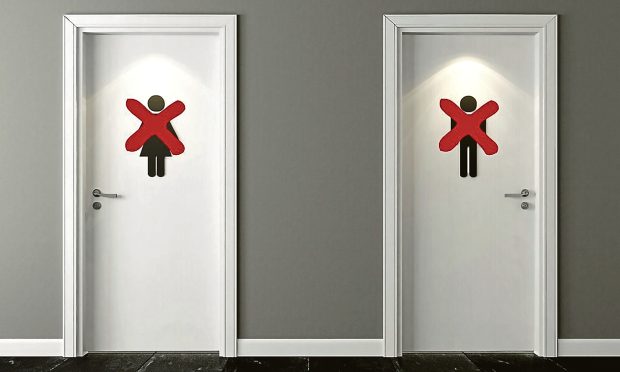
Schools across Scotland are breaking the law over the adequate provision of toilets, leaving themselves open to legal action from pupils and parents.
Only 13 of the 243 secondary schools that took part in a survey complied with non-harassment obligations under equality law and the School Premises Regulations by providing adequate numbers of single-sex toilets.
Just three – Islay High and Tarbert High in Argyll & Bute, and Castlebay in the Western Isles – fully complied by providing adequate single-sex toilets and informing pupils they cannot use opposite-sex toilets.
One in 20 schools which took part in the survey, carried out by campaign group For Women Scotland (FWS), provided only mixed-sex toilets. And 16% provided a combination of mixed-sex and single-sex toilets.
Trina Budge of FWS said: “Our shocking research confirms how widespread the practice of toilet sharing is becoming, increasing the risk of sexualised bullying, particularly for young girls.”
Single-sex toilet provision
The law states schools must provide separate single-sex toilets for both boys and girls.
Boys must also have access to an adequate number of urinals.
But, following pressure to provide facilities for gender questioning pupils, more schools are removing single-sex toilets and replacing them with shared bathrooms.
Gender-questioning pupils are also being allowed to access opposite-sex toilets.
The Scottish Government says transgender pupils should “use the toilet facilities they feel most comfortable with”.
Budge said: “Schools are breaking the law and leaving themselves open to legal action from pupils or parents, and they are also increasing the risk of the bullying and harassment of young girls by failing to provide safe single-sex spaces.
“We’ve heard reports of girls being so embarrassed to use mixed-sex toilets, especially during their periods, they are forcing themselves to wait until school break so they can access facilities outside the premises. This can cause health issues.”
Concerns were raised over mixed-sex toilets when they were first introduced at Jedburgh Grammar and Kelso High over three years ago following claims boys were “waving period products around like flags” and urinating in sanitary bins.
Worryingly, research also indicates one rape takes place every day across schools in the UK.
Budge said: “Ten years ago, there were no issues over shared toilets. It is only since the introduction of gender ideology, which is now deeply embedded in schools oblivious to the harms it causes children, particularly girls, that we have seen an increase in mixed-sex toilets.
“We frequently receive requests for help and advice from parents whose daughters are avoiding mixed-sex toilets or have been victims of boys exposing themselves or bullying.”
Carolyn Brown, one of Scotland’s foremost educational psychologists, warned: “The Scottish Government guidance driving this, Supporting Transgender Pupils In Schools, is deeply flawed. It is non-statutory, and schools would be well advised to avoid using it.
“Many boys as well as girls experience feelings of discomfort and embarrassment where a teenager says they identify as the opposite sex and enters a toilet accordingly.
“There is good evidence to indicate that those feelings of discomfort are likely to be even worse for girls as they learn to adjust and cope with bodily changes as a result of puberty.
“Both teenage sexes require toilet facilities that allow for dignity and privacy. Teenagers are naturally extremely self-conscious. They are acutely aware of how their bodies are changing and the majority are easily embarrassed.
“There are already studies reporting on the increase of mental health issues for teenagers. The addition of the uncertainties and anxieties created by mixed-toilet policies only operate to exacerbate teenage mental health issues.”
‘Girls at greater risk’
Karen Ingala Smith, a respected campaigner on the abuse of women and girls said: “It’s intolerable that the issue has not been addressed, indicating blatant disregard for the physical and emotional safety of girls and young women.
“Research suggests an average of one rape every day of the school year.
“Increasing boys and young men’s access to girls and young women in places where there are rarely adults puts girls at greater risk.”
Mary Sharpe, CEO of the Reward Foundation which provides guidance for schools, said: “It’s one thing if single-sex toilets are occupied and a girl chooses to use a mixed-sex one out of necessity. To make it the only option is totally unacceptable.
“The increase in sexual harassment and bullying in recent years, often focusing on body image and identity, makes the restriction of single-sex toilets riskier. Schools must put the dignity and health needs of vulnerable young adolescent women before political agendas or financial constraints.”
Maya Forstater, CEO of human-rights charity Sex Matters said: “This report reveals a shocking failure to provide adequate single-sex facilities for both boys and girls across Scottish schools.
“This will have had predictably serious consequences, including school absenteeism and an increased risk of bullying and abuse.
“It is abundantly clear that updated guidance for Scottish schools is urgently needed to halt this state-sanctioned failure to safeguard children of both sexes, but especially girls who are at particular risk when single-sex provision is undermined.”
Scottish Conservative deputy leader Meghan Gallacher said: “Parents and pupils will be alarmed by these figures if it means that gender-neutral toilets are becoming the norm.
“It has been a long-standing position of the Scottish Conservatives that every child should be able to access single-sex toilets at school.
“Introducing gender-neutral toilets should never come at the expense of single-sex toilets ,which provide young people, in particular young girls, the safe space they are entitled to.
“Councils must consider the needs of all children.”
The Scottish Government says it is updating the School Premises Regulations and will be consulting on changes proposed.
It said: “The provision of toilets is a matter for local authorities.”

Enjoy the convenience of having The Sunday Post delivered as a digital ePaper straight to your smartphone, tablet or computer.
Subscribe for only £5.49 a month and enjoy all the benefits of the printed paper as a digital replica.
Subscribe